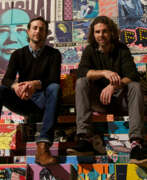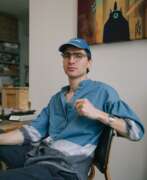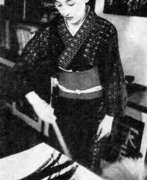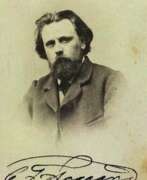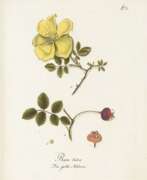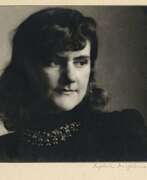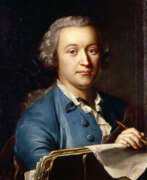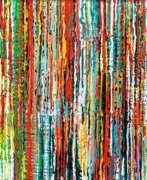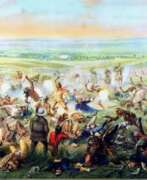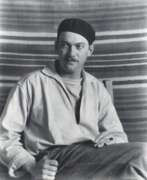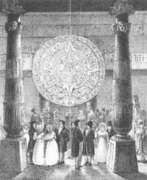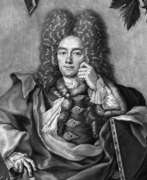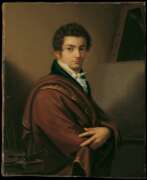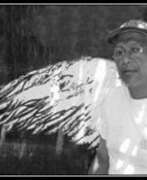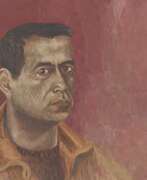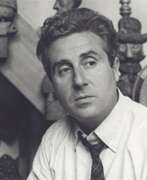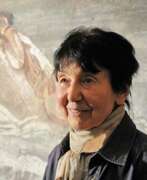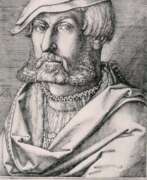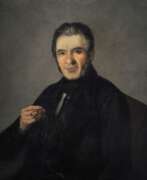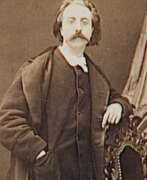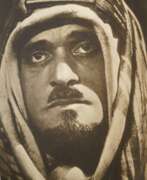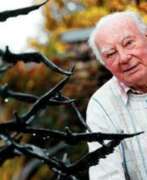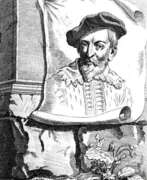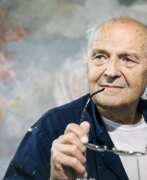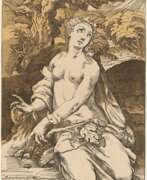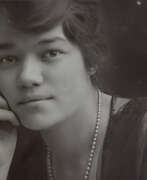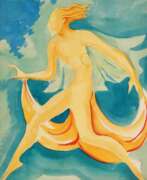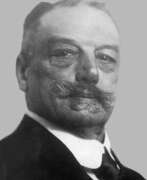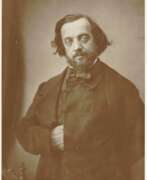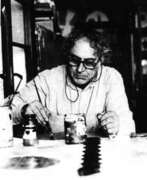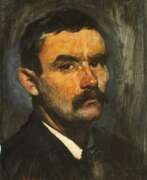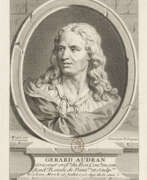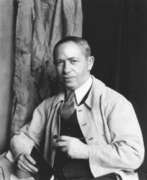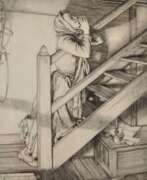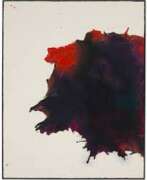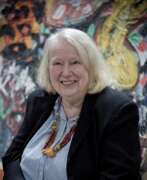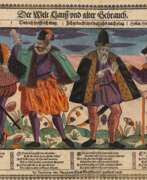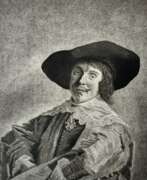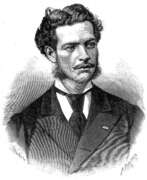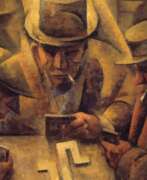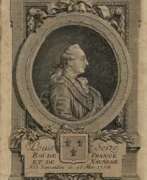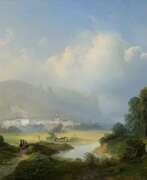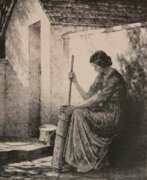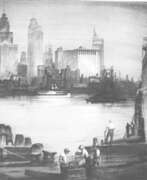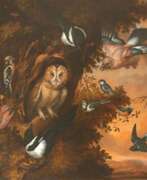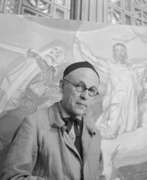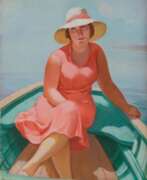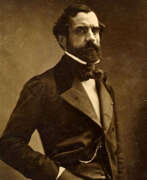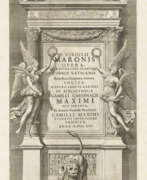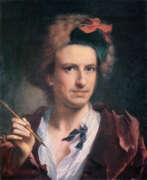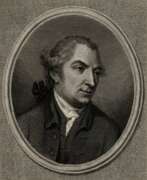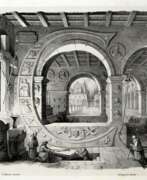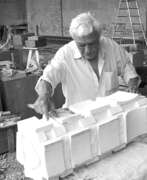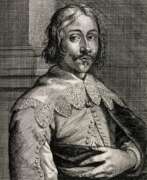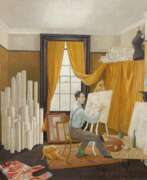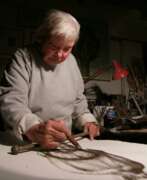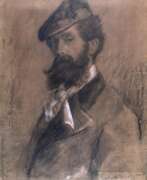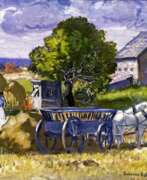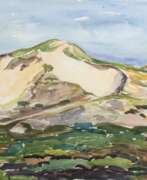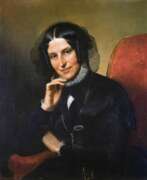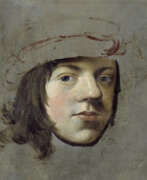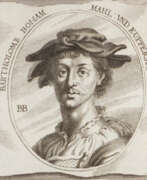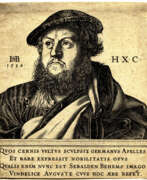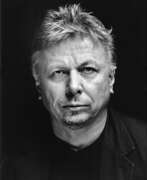Engravers
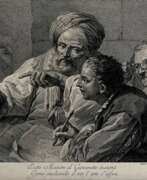

Antonio Capellan was an Italian engraver, active in a Neoclassical style. He trained with Joseph Wagner. Capellan is best known for making engraved copies of masterworks of the Italian Renaissance found in private collections, which were published in Gavin Hamilton's work, Schola Italica Picturae. He also engraved a series of portraits of cardinals titled "Calcographia R.C.A. apud Pedem Marmoreum". In 1759, he engraved portraits of Michelangelo and Giorgio Vasari for a volume of the life of Vasari, curated by Bottari.
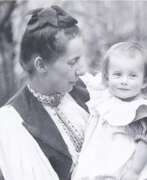

Jenny Fikentscher (born Nottebohm) was a German painter and graphic artist associated with the Art Nouveau movement. She studied at the School of Women Painters in Karlsruhe and later became part of the Grötzingen artist colony. Fikentscher married animal painter Otto Fikentscher and raised five children in an unconventional artistic household. She was known for her botanical motifs and lithographs, often featuring local plants. Fikentscher also created collectible images for the Stollwerck chocolate company.
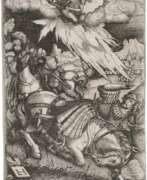

Lambert Hopfer, an active German artist in the first half of the 16th century, made a name for himself in the realm of art through his distinctive etchings. Though details about his life are scarce, Hopfer's work has endured the test of time, offering a unique window into the art and culture of his era.
Hopfer's contributions to the art world are primarily characterized by his etchings, which showcase a remarkable skill in this medium. He was active around 1525-1550, a period that saw a flourishing of artistic expression in Germany. Among his notable works is the "Candelabra Grotesque with Heads of Dolphins and Dragons in the Center," an etching that exemplifies the intricate and detailed style he was known for. This piece is part of the collection at The Metropolitan Museum of Art, highlighting its artistic significance.
Though not as widely known as some of his contemporaries, Lambert Hopfer's works remain important to collectors, auctioneers, and experts in art and antiques, particularly those with an interest in the development of printmaking techniques during the Renaissance period. His etchings offer valuable insights into the artistic styles and cultural themes of his time.
For those interested in exploring Lambert Hopfer's artistic legacy further, staying informed about exhibitions featuring his work and opportunities to acquire his pieces would be highly beneficial. Engaging with Hopfer's art provides a deeper appreciation of the intricate techniques and cultural context of 16th-century German etchings.
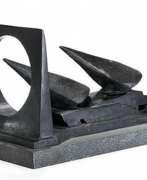

Jan Leth Aagensen was a Danish artist. He made his name as a lithographer and later became known for his sculptures.
Jan Leth's formal training took place at the Royal Danish Academy of Fine Arts under Professor Søren Hjort Nielsen from 1965 to 1969. His first exhibition took place in 1961 at Kunstnernes Forårudstilling (Spring Artists' Exhibition). He is a member of various art groups: Decembristerne, Kunstnersamfundet og Foreningen Danske Grafikere, the Association of the Royal Danish Academy of Fine Arts and the Association of Danish Painters Engravers.
Jan Leth has participated in various solo and group exhibitions, presenting paintings, sculptures, drawings, and installations in Denmark and abroad. He has received many honours and grants throughout his life. The Danish State gave him a lifelong economic grant in 1998. His work is represented in gallery collections in Denmark and internationally.
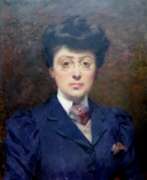

Louise Abbéma was a French painter, sculptor, and designer, celebrated for her work during the Belle Époque. Born in Étampes in 1853 into an affluent Parisian family, she became well known for her portraits, particularly of the famous actress Sarah Bernhardt, and for decorative panels commissioned for various public buildings in Paris and the Palace of the Governor in Dakar, Senegal.
Abbéma's art often depicted the upper echelons of French society and reflected the Impressionist style through her light and rapid brushstrokes. She was also notable for her involvement in the women's movement, where she contributed to the emerging image of the 'New Woman' by portraying androgynous figures and themes of intellectualism and freedom.
Among her many honors, Abbéma was awarded the Palme Academiques in 1887, nominated as the Official Painter of the Third Republic, and in 1906, she became a Chevalier of the Legion of Honour. Her works, such as "Lunch in the Greenhouse" and "Portrait of Sarah Bernhardt," have seen a resurgence in popularity as the contribution of women to historical art gains more recognition.
For those interested in the evocative and historically rich artworks of Louise Abbéma, consider subscribing to our updates. We'll keep you informed about new sales, auctions, and exhibitions featuring Abbéma's work, ensuring you're always connected to the latest offerings in the art and antique collectors' sphere.
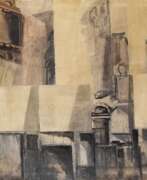

Peter Ackermann was a German painter and graphic artist. He became known for his alienation of architectural subjects. Ackermann was a representative of fantastic realism. The preferred subject of his work was classical Italian architecture, which he drew on site. He put together columns, portals and walls with machine parts, ruins and desolate parts of the city, which were piled up threateningly and thus alienated. In his etchings he showed references to the techniques of the old masters, his pictorial conception is compared with that of Giovanni Battista Piranesi and Canaletto.
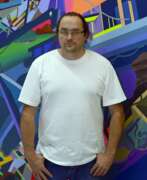

Franz Ackermann is a German media artist.
He studied at the Academy of Fine Arts in Munich and at the University of Fine Arts in Hamburg, lives and works in Berlin and Karlsruhe.
Franz Ackermann's work includes drawings, watercolors, murals, paintings and installations, which he complements with photographic works, projections and architectural models. His works deal with the themes of tourism, globalization and urbanism and reflect the social changes and political problems caused by increasing globalization.
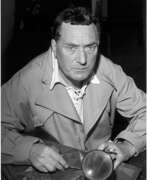

Henri-Georges Adam was a French engraver and non-figurative sculptor of the École de Paris, who was also involved in the creation of numerous monumental tapestries. His work in these three areas is regarded as among the most extensive of the twentieth century.
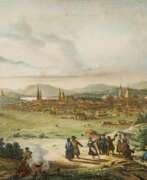

Jean-Victor Vincent Adam was a French painter and lithographer.
Adam came from a dynasty of artists and studied at the École des Beaux-Arts in Paris. He painted views of various cities, including Russian Kazan and Yekaterinburg, as well as battle scenes from Napoleon's military campaigns. Collections of images of French military costumes prepared by Adam were published. His genre paintings with hunting scenes and animals are also known.
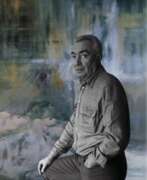

Giuseppe Ajmone was an Italian painter and printmaker.
He studied painting at the Brera Academy of Fine Arts in Milan and in 1946 was one of the signatories of the Realist Manifesto, also known as "Oltre Guernica.
Ajmone painted both landscapes and still lifes as well as semi-abstract figures.
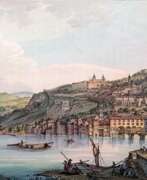

Jean-François Albanis Beaumont was a French landscape painter, engineer, traveler and geographer.
He studied engineering in Paris and worked on architectural structures at Chambérly. Beaumont later accompanied the Duke of Gloucester, William Frederick of Hanover on a grand tour of Germany, Italy, France, and Switzerland, making notes and detailed pictorial sketches of views along the way. In 1800 he published the illustrated books Journey to the Lepontine Alps from France to Italy and Description of the Grecian and Cottian Alps (1802 and 1806).


Cherubino Alberti, also called Borghegiano, was an Italian engraver and painter. He is most often remembered for the Roman frescoes completed with his brother Giovanni Alberti during the papacy of Clement VIII. He was most prolific as an engraver of copper plates.
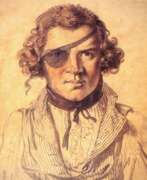

William Alexander was a British painter, illustrator and printmaker.
He studied painting at the Royal Academy and became a very famous artist. In 1792-1794 he accompanied the official embassy to Peking of Lord George Macartney on behalf of the British government, where he documented the visit and made many drawings of the Chinese court. These depict various mandarins, merchants, members of the royal family and members of Chinese society. In 1805, William Alexander published Costume of China, an album illustrated with 48 color prints, which was a success with the public.
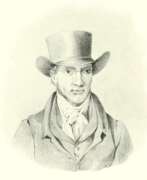

Henry Thomas Alcken was an English painter and engraver chiefly known as a caricaturist and illustrator of sporting subjects and coaching scenes. His most prolific period of painting and drawing occurred between 1816 and 1831.


Samuel Alken the Elder was a British painter, printmaker and illustrator.
Samuel Alken studied at the Royal Academy School in London. In 1779 he published A New Book of Ornaments Designed and Engraved by Samuel Alken, and later established himself as one of the most distinguished engravers in the new technique of aquatint. Alken produced magnificent compositions of the British countryside, including moonlit night scenes. His works include engravings by George Morland, Richard Wilson, Thomas Rowlandson, and Francis Wheatley. In 1796 his plates of sixteen views of the lakes of Cumberland and Westmorland, after drawings by John Ames and John Smith, were published, and in 1798 a set of aquatint views of North Wales after drawings by the Rev. Brian Broughton.
His sons, Samuel Alken the Younger (1784-1824), Henry Thomas Alken (1785-1851) and Samuel Henry Alken (1810-1894) also became artists.
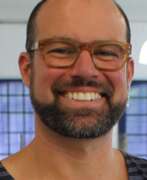

Luis M. Alonzo-Barkigia is a contemporary Mexican artist. He studied at the Malmö Academy of Art (Sweden) and at the University of Illinois at Chicago. He was awarded the UIC Presidential Fellowship, the Larsen Fellowship for Studio Arts.
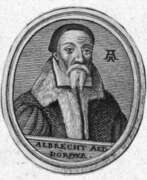

Albrecht Altdorfer, a notable German painter, engraver, and architect of the Renaissance era, was especially recognized for his contributions to landscape painting. Born around 1480, Altdorfer was a pivotal figure in the Danube School, distinguishing himself with his integration of natural landscapes into biblical and historical narratives.
His works are celebrated for their detailed and expressive landscapes, often serving as backdrops to religious and historical scenes. A hallmark of his style is the emotional intensity and vivid use of colors, which border on expressionistic in his religious scenes, particularly seen in works like the Sebastian Altar in St. Florian's Priory. Altdorfer's painting, "The Battle of Alexander at Issus," stands out for its epic portrayal of Alexander the Great's victory, showcasing Altdorfer's talent in blending historical narrative with dramatic landscape settings.
In addition to his artistic pursuits, Altdorfer was actively involved in the civic life of Regensburg, serving as its mayor in 1528. His legacy in the art world is profound, with his innovative approach to landscape painting influencing the course of European art.
For those interested in delving deeper into Albrecht Altdorfer's oeuvre or staying informed about related exhibitions and auction events, signing up for updates can provide valuable insights and opportunities.
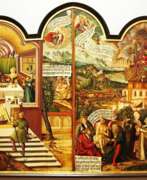

Erhard Altdorfer, a German Early Renaissance printmaker, painter, and architect, is renowned for his contributions to the arts during the 16th century. Born around 1480, Altdorfer's career flourished in Schwerin, where he served as a court painter and architect for the Dukes of Mecklenburg from 1512 until his death in 1561. His journey into the arts likely began under the guidance of his older brother, Albrecht Altdorfer, a prominent figure in the same era.
Altdorfer's early work possibly included collaboration with his brother in Regensburg. By 1512, his talents led him to Schwerin, marking the start of a significant phase in his career. His oeuvre includes various forms, from engravings and woodcuts to paintings and architectural designs. Notable among his works are contributions to the Lübeck Bible, showcasing his skill in woodcut illustrations. Despite the limited number of signed works, his contributions to printmaking and painting hold a place in the history of German Renaissance art. His works, reflecting a blend of influences, including from Lucas Cranach the Elder and Jacopo de' Barbari, demonstrate a unique interpretation of the Renaissance style.
For collectors and experts in art and antiques, understanding Altdorfer's role within the context of the Early Renaissance and his contributions, especially in printmaking and painting, offers a nuanced appreciation of this period. His works, though not as prolifically signed as those of some contemporaries, remain significant for their historical and artistic value. To stay updated on new discoveries or auction events related to Erhard Altdorfer's works, consider signing up for updates to deepen your knowledge and collection of Renaissance art.
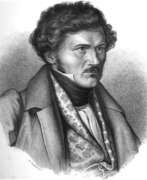

Samuel Amsler is a Swiss engraver. He studied his art under Johan Heinrich Lips and Karl Ernst Hess, at Munich, and from 1816 pursued it in Italy, and chiefly at Rome, till in 1829 he succeeded his former master Hess as professor of engraving in the Munich academy. The works he designed and engraved are remarkable for the grace of the figures, and for the wonderful skill with which he retains and expresses the characteristics of the original paintings and statues. He was a passionate admirer of Raphael, and had great success in reproducing his works.
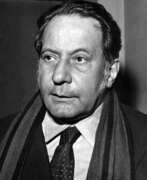

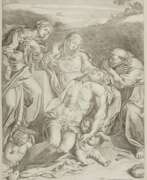

Pietro Aquila was an Italian painter and printmaker of the Baroque period. He was born in Palermo. He mentored his nephew, the printmaker Francesco Faraone Aquila. He trained at the school of Palermo painter and engraver Pietro del Po and worked, like a teacher, first at home, in Palermo, then in Naples and Rome, where he pursued the ecclesiastical career. For his paintings that he left in Palermo in the church of the Pietà (Parabola del Figlio Prodigo, Abraham and Melchizede) and in the cloister of S. Maria delle Vergini (S. Benedetto), as well as some frescoes in the Chapel of the Rosary in S. Cita, he gained the status of "respectable painter", loyal to the Raphaelesque tradition. But Aquila established himself first and foremost as a copper engraver, dedicating himself to the distribution and popularization of many of the most remarkable paintings with the help of which the sacred and profane buildings of Rome were adorned at that time. He made engravings after the works of different artists that were dear to him including: Raphael before any other, and then Annibale Carracci, Pietro da Cortona, Giovanni Lanfranco, Lazzaro Baldi, Ciro Ferri, Morandi, Franceschini, and finally Carlo Maratta, who was bound to him by a close friendship.


Francesco Faraone Aquila was an Italian engraver. In 1690 he moved to Rome where his brother Pietro had been an engraver for several decades in major workshops in the capital. Pope Clement XI gave him an order which has remained his main work - engraving the bas-reliefs of the Antoninus Pius column and its pedestal. Another important work by Francesco Aquila is the engraving of the frescoes of the dome of the Cathedral of Parma by Correggio and the painting of the Vatican chambers. Following the antique taste established in the 18th century, Aquila engraved various Roman classical works: statues, vases and triumphal arches, thus satisfying the demand of mainly foreign visitors, mainly German and English. His portraits of his contemporaries, both painters and clergymen, also enjoyed great popularity.
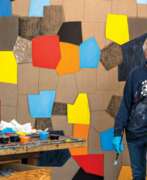

Charles Arnoldi is an American painter, sculptor and printmaker.
In the early 1970s, the artist attracted attention for his wall-relief wood sculptures, such as Honeymoons in the collection of the Honolulu Museum of Art.
The use of wood remained a feature of Arnoldi's oeuvre, although, since the 1980s, he has often employed it in combination with other media. In the 1990s, Arnoldi's output changed radically. He began producing abstract paintings on canvas, first black and white, and later brightly colored.
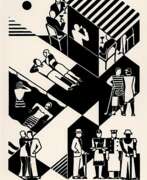

Gerd Arntz was a 20th-century German artist known for his skillful woodcut prints. A member of the Cologne Progressives—a group concerned not just with social and political issues, but also with the public’s ability to understand these concepts—Arntz sought to use his art as a method of delivering crucial information to the masses. Over the course of his life, he designed approximately 4,000 pictograms known as ISOTYPEs, or International System of Typographic Picture Education, a unique form of symbolized data from industries, politics, and economic phenomena intended for use by those who could not read.
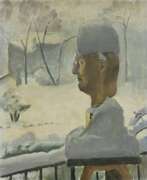

Maurice Paul Jean Asselin was a French painter, watercolourist, printmaker, lithographer, engraver and illustrator, associated with the School of Paris. He is best known for still lifes and nudes. Other recurring themes in his work are motherhood, and the landscapes and seascapes of Brittany. He also worked as a book illustrator, particularly in the 1920s. His personal style was characterised by subdued colours, sensitive brushwork and a strong sense of composition and design.
He was awarded the rank of Officier de la Légion d'honneur in 1939.
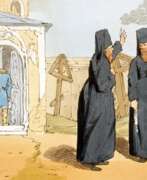

John Augustus Atkinson was a British watercolorist, illustrator and engraver.
In 1784, the young Atkinson traveled to St. Petersburg, Russia, to stay with his uncle James Walker, who worked as an engraver at the court of Empress Catherine the Great. The aspiring artist learned from the work of the great Russian painters whose paintings he saw in the art galleries of St. Petersburg. Catherine and her son Paul I, noticing his talent, commissioned Atkinson to paint pictures on historical subjects.
In 1801 Atkinson returned to England and a year later published an album entitled "Pictorial representation of Russian manners, customs and amusements" on 100 plates drawn and engraved by himself. This work was a great success in Europe. Later, during the Napoleonic Wars, Atkinson created many battle scenes, including the Battle of Waterloo and naval battles. In 1808 he was elected to the Society of Watercolor Painters.
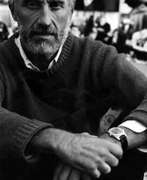

Ugo Attardi was an Italian painter, sculptor and writer. Attardi moved from Genoa to Rome in the early 1950s, where he formed the group Forma 1 together with other artists. His sculpture of Ulysses is now permanently installed in Battery Park in New York
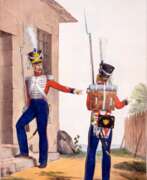

Charles Aubry was a French painter, illustrator and caricaturist who worked in Saumur from 1810-1840.
From 1817. Aubry made drawings and illustrations of military costume. He was soon recognized as one of the best lithographers and draughtsmen of military scenes, showing a particular talent for depicting cavalry. Charles Aubry's colored lithographs were published in a publication on the uniforms of the Swiss Royal Guard (Collection des Uniforms de l'Armee Francaise, 1823), as well as caricatures in the Comic Album de Pathologie (1823).
In 1822 Charles Aubry was appointed professor of art at l'Ecole Militaire de Saumur.
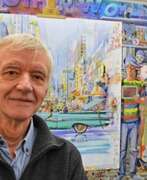

Daniel Authouart is a French painter, draughtsman and lithographer.
He studied at the École des Beaux-Arts in Rouen and lives and works in the same city. Authouart is known for his hyper-realistic paintings and lithographs on themes of modern life. He also created book bindings, posters and theater sets.
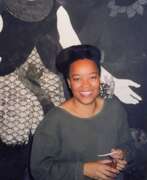

Belkis Ayón was a Cuban printmaker who specialized in the technique of collography. Ayón created large, highly-detailed allegorical collographs based on Abakuá, a secret, all-male Afro-Cuban society. Her work is often in black and white, consisting of ghost-white figures with oblong heads and empty, almond-shaped eyes, set against dark, patterned backgrounds.
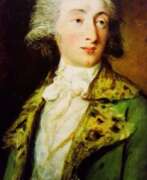

Carl Daniel David Friedrich Bach was a German artist of the late eighteenth and early nineteenth centuries, the Baroque period. He is known as a painter, graphic artist and printmaker.
Bach worked in the historical genre, was a portraitist, animalist, created canvases on allegorical subjects in the spirit of his era. In his works he combined elements of baroque and classicism. The artist often worked in the etching needle technique.


Aino Bach (Russian: Айно Густавовна Бах) was an Estonian and Soviet artist of the twentieth century. She is known as a painter, graphic artist and printmaker.
Aino Bach was one of the first Estonian printmakers to demonstrate mastery of the intaglio technique, which expanded the possibilities of engraving. Her work includes portraits, genre compositions and illustrations. She employed a variety of techniques including gravure printing, metal engraving, and color monotype. Her works often combined different techniques, giving them a distinctive flavor.
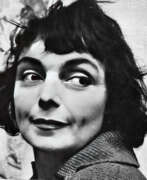

Bele Bachem (real name Renate Gabriele Bachem) was a German painter, graphic designer, book illustrator, interior designer and writer. In 1997 Bachem was awarded the Order of Merit of the Federal Republic of Germany.
Bachem is considered one of the most important post-war German artists and one of the few surrealists in the illustration of German literature.
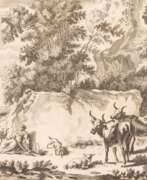

Elias Baeck called "Heldenmuth", was a German painter and engraver from Augsburg. Baeck worked for some time in Rome, then in Laybach, but finally returned to Augsburg, where he died in 1747. His chief works — both in painting and engraving — were portraits and landscapes. His engravings are sometimes signed "E.B.a.H.", standing for "Elias Baeck, alias Heldenmuth".
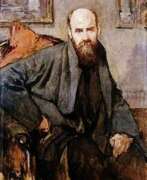

Albert Baertsoen was a Belgian painter, pastellist and graphic artist. His debut as a painter came in 1887, when he participated in an exhibition in Brussels held by the secessionist group l'Essor. He continued his studies in Paris, at the art school of Alfred Philippe Roll, and exhibited at the Salon in 1889. In 1894, he helped found the "Cercle des Beaux-Arts d'Ostende". From 1896 to 1901, he continued to exhibit throughout Europe, winning several Gold Medals. In 1913, he served as a member of the art jury for the Ghent World's Fair. During World War I, he lived in London, returning to Ghent in 1919. That same year, he was appointed a member of the Royal Academy of Belgium.
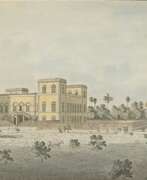

William Baillie was a British artist who lived and worked in India in the late 18th century.
He went to India in 1777 as a cadet in the Bengal Infantry and remained there for the rest of his life. After retiring, he published a newspaper in Calcutta, painted landscapes with views of the city and surrounding countryside, made engravings, and made topographical maps. In 1794, William Baillie published a set of hand-colored aquatints entitled Twelve Views of Calcutta.
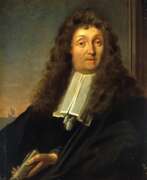

Ludolf Bakhuizen was a Dutch painter of the 17th and early 18th centuries. He is known as an outstanding master of seascapes. Bakhuizen also painted biblical themes and portraits of his contemporaries as well as engravings and miniature models of ships.
Ludolf Bakhuizen is considered one of the best marine painters of the Golden Age of Dutch painting. Among the admirers of his work were many influential European rulers, including the Russian Tsar Peter the Great. The master met Peter I, who visited Amsterdam in the mid-1690s and, according to contemporaries, even managed to give some painting lessons to the Russian tsar. In addition, Вakhuizen made models of all kinds of ship designs on commission from Peter the Great.
Toward the end of his life, the Amsterdam authorities honored Bakhuizen by opening his own gallery on the top floor of the City Hall for his achievements in the fine arts. The best masterpieces of his work are now preserved in museums in the Netherlands, Germany, England, France, and Italy.
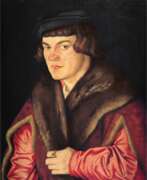

Hans Baldung, also known as Hans Baldung Grien, was a prominent figure in the German Renaissance, celebrated for his innovative approach to painting, printmaking, and drawing. Born around 1484 in Schwäbisch Gmünd, Germany, and passing away in 1545 in Strasbourg, France, Baldung's career was marked by a distinctive style that art historians have associated with the mannerist tendencies of the time. His work is notable for its exploration of themes such as the imminence of death, the complexities of human sexuality, and scenes of witchcraft, distinguishing him from his contemporaries with a bold and unique artistic voice.
Educated in the workshop of Albrecht Dürer, Baldung quickly developed his own artistic language, absorbing and then transcending Dürer's influence. He is particularly renowned for his altarpieces, portraits, and a series of works that delve into eroticism and the supernatural. Among his most significant contributions is the high altar of the Freiburg Münster, an eleven-panel masterpiece depicting scenes from the life of the Virgin Mary, which remains a testament to his mastery over religious subjects even as he ventured into more secular and profane themes.
Baldung's fascination with witchcraft and his portrayal of witches in art were groundbreaking for the time. His works in this area, such as "The Witches' Sabbath" and "Weather Witches," reveal a complex interplay of humanist thought, classical literature, and contemporary beliefs about witchcraft. They offer a nuanced perspective that blends satire with a deeper commentary on human nature and societal fears, marking Baldung as a pioneer in the visual exploration of these themes.
Despite his engagement with the themes of death and witchcraft, Baldung's oeuvre is also rich in portraits characterized by sharp individualization and psychological depth, as well as altarpieces that convey a profound spiritual and theological insight. His ability to navigate between the realms of the divine and the earthly, the solemn and the profane, solidifies his position as a versatile and innovative artist of the Renaissance.
For collectors and experts in art and antiques, Hans Baldung's work offers a unique window into the confluence of Renaissance artistry, humanist thought, and the socio-religious dynamics of early 16th-century Europe. His paintings and prints not only adorn museums and galleries worldwide but also continue to inspire and provoke deep reflection on the human condition.
To stay informed about new discoveries, exhibitions, and auction events related to Hans Baldung's art, signing up for updates can provide enthusiasts and collectors with valuable insights into the enduring legacy of this remarkable artist. This subscription service is designed to alert subscribers to new product sales and auction events specifically related to Hans Baldung, ensuring that they remain at the forefront of developments in the field of Renaissance art and antiques.
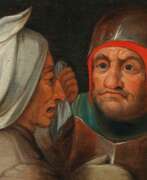

Pieter Balten or Pieter Custodis was a Flemish Renaissance painter, etcher, draftsman, publisher, and poet. He was a member of the Guild of St. Luke in Antwerp.
Pieter Balten is considered one of the pioneers of realistic depictions of village life, often comic. He also painted religious compositions, landscapes and painted tronies - portraits with comic and even caricatured facial images.
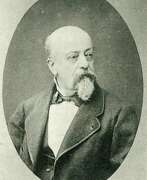

Henri Charles Antoine Baron was a French painter, printmaker and illustrator.
Henri studied painting with Jean Gigoux (1806-1894) and traveled with him in Italy. The Baron returned with a large number of sketches, which became a constant source of inspiration for many of his later works. He first successfully exhibited at the Paris Salon in 1840. Baron was subsequently honored with several gold medals for his work at this Salon.
Henri Baron was the author of historical scenes of social life, oriental and allegorical compositions. He painted charming Italian genre scenes and depicted Parisian social life. The artist was also recognized as a skilled watercolorist, exhibiting his watercolors continuously at the Society of French Watercolorists since 1879. Baron also illustrated works by Balzac, Boccaccio, J. J. Rousseau, Perrault's fairy tales and many others.
In addition, in collaboration with his friend F.-L. France and Célestin Nantey (1813-73), he published a three-volume edition of Ancient and Modern Painters (1848-62), a collection of lithographs based on the works of modern artists.
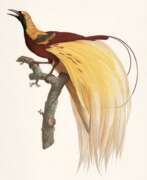

Jacques Barraband was a French zoological and botanical illustrator, renowned for his lifelike renderings of tropical birds. His pictures were based on mounted specimens and his illustration was considered the most accurate ones made during the early 1800s.
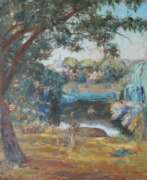

Ethel Barringer was a South Australian artist who excelled in various media, but was particularly known for her etchings. She was educated at the Advanced School for Girls under Miss Rees George, and was a student of Hans Heysen and Mary Packer Harris at the SA School of Arts and Crafts. She studied in London for several years and took courses in enamelling, jewellery designing, life work, and etching at the St John's Wood Art School and the Sir John Cass Technical School. On her return to Adelaide she set up a studio of her own in Flinders Street, but gave it up when she gained an appointment as assistant teacher at the School of Arts and Crafts on North Terrace.
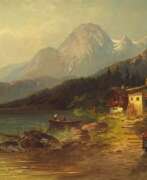

Constantin Ludwig Bauer was a German painter. Numerous landscape watercolors come from Bauer. Bauer studied from 1869 to 1873 at the Academy of Fine Arts in Munich. He learned figure painting from Alexander Wagner and copperplate engraving from Johann Leonhard Raab. In 1878 Bauer moved to Obermais (South Tyrol). There he devoted himself to landscape painting.
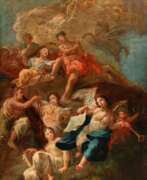

Johann Wolfgang Baumgartner was an Austrian-German Rococo painter.
He worked as a glass painter. The ceiling painting in the Sanctuary of the Holy Cross of the former Klosters Mountains is considered as his largest and most important work.
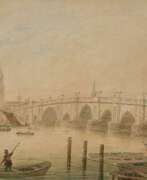

Thomas Mann Baynes was a British painter and draughtsman and lithographer.
Thomas Mann Baynes was born into the family of the famous watercolorist James Baynes. He traveled extensively throughout Ireland during his career, creating romantic and pastoral views of the countryside that were popular in the 19th century. Many of these were later engraved and published. Baynes also created many architectural landscapes with monumental buildings, such as views of the Thames in London and the Canterbury and Whitstable Railway. Today, these engravings are of great historical value.
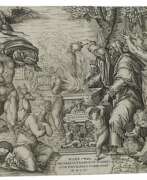

Nicolas Béatrizet (or Beatrizet, or Beatricetto) was a 16th century French engraver, working in Rome. Béatrizet was born at Luneville in or before 1520. From his style, it has been conjectured that he was a scholar of Ghisi and Agostino Veneziano de Musis. From 1540 to 1560, he engraved under the direction of Michelangelo. The importance of Béatrizet's works lay in the fact that his engravings were unique records of pictures by some of the greatest artists rather than their inherent quality. He usually signed his plates with the letters "N. B. L. F.". Their number is considerable, but most of them are included in the following list.
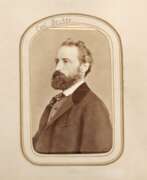

Carl Emil Rudolf Ludwig Becker was a German marine artist.
He was awarded gold medals at the International Art Exhibition of 1894, in Vienna, and the Große Berliner Kunstausstellung of 1896. Three years later, he was one of the co-founders of the Düsseldorfer Künstler-Vereinigung (artists' association). After the turn of the century, marine painting was heavily promoted by Kaiser Wilhelm II, who was attempting to make Germany a major sea power. As a result, the demand for Becker's paintings increased farther inland.


Peter Becker is a German landscape painter, engraver, and lithographer. In his many landscape works he romanticizes the German forest and enlivens it with historical characters. He also painted genre scenes and depicted city streets.
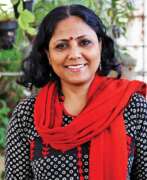

Tayeba Begum Lipi is a Bangladeshi artist and the co-founder and trustee of Britto Arts Trust. She has received Grand Prize at the 11th Asian Art Biennale, Bangladesh 2004. Lipi is a multimedia artist who has engaged in paintings, prints, installations and videos. Her works have been featured in notable group exhibitions, including the 54th Venice Biennale (2011) and Colombo Art Biennale (2012). She was also the commissioner for the Bangladesh Pavilion at the 54th Venice Biennale (2011).
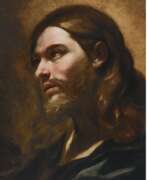

Giovanni Battista Beinaschi, an Italian painter and fresco artist of the Baroque era, was born in 1636 and left an indelible mark on the art world before his death in 1688. Renowned for his dynamic compositions and vibrant use of color, Beinaschi's work epitomizes the grandeur and emotive power of Baroque art, reflecting the period's cultural and artistic aspirations.
Beinaschi's contributions to art are notable for their intricate details, dramatic use of light and shadow, and the emotional intensity of the figures portrayed. His mastery in fresco and oil painting allowed him to create expansive religious narratives and intimate portraits alike, each brimming with life and depth.
Among his celebrated works, those housed in esteemed museums and galleries across Europe serve as testaments to his skill and creativity. Beinaschi's frescoes, in particular, are admired for their architectural harmony and the seamless integration of figures into their surroundings, showcasing his innovative approach to spatial composition.
For collectors and experts in art and antiques, Giovanni Battista Beinaschi's paintings are more than just visual delights; they are windows into the soul of the Baroque period. His ability to convey complex emotions and spiritual themes through art makes his works highly sought after and revered in the history of painting.
If you wish to delve deeper into the world of Baroque art and explore the genius of Giovanni Battista Beinaschi, consider signing up for updates. This subscription will keep you informed about new discoveries, sales, and auction events related to Beinaschi's works, ensuring you never miss an opportunity to appreciate or acquire pieces by this exceptional artist.
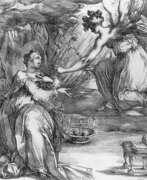

Jacques Bellange was an artist and printmaker from the Duchy of Lorraine (then independent but now part of France) whose etchings and some drawings are his only securely identified works today. They are among the most striking Northern Mannerist old master prints, mostly on Catholic religious subjects, and with a highly individual style. He worked for fourteen years in the capital, Nancy as court painter to two Dukes of Lorraine, before dying at the age of about forty, and almost all his prints were produced in the three or four years before his death. None of his paintings are known to have survived, but the prints have been known to collectors since shortly after his death, though they were out of critical favour for most of this period. In the 20th century they have been much more highly regarded, although Bellange is still not a well-known figure.


